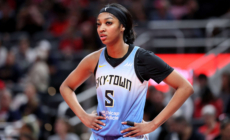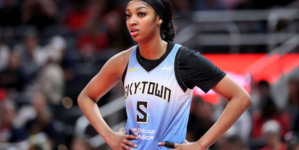-
How to Watch Padres vs Brewers: Live Stream MLB, TV Channel - 33 mins ago
-
LIV Golf Virginia: Second Round Highlights | LIV on FOX - 35 mins ago
-
How to Watch Red Sox vs Yankees: Live Stream MLB, TV Channel - about 1 hour ago
-
Red Sox vs. Yankees Highlights | MLB on FOX - about 1 hour ago
-
Trump Deploys National Guard to LA Amid Immigration Protest Clashes - 2 hours ago
-
Padres vs. Brewers Highlights | MLB on FOX - 2 hours ago
-
How to Watch Indiana Fever vs Chicago Sky: Live Stream WNBA, TV Channel - 2 hours ago
-
Could Mauricio Pochettino leave USMNT for Tottenham?: ‘It’s not realistic’ - 3 hours ago
-
Jennifer Garner admits doctors talked her out of plastic surgery - 3 hours ago
-
MLB Insider Lists Yankees Interim Closer as Potential Trade Candidate - 3 hours ago
Donald Trump’s Gen Z Popularity Plunges
President Donald Trump’s favorable rating among Generation Z voters has dramatically fallen since the 2024 election, according to a poll.
A survey from The Economist/YouGov released Wednesday revealed the president’s net favorability rating among those aged 18-29 is minus 18 points. This is a drop from the plus 19 favorable rating he scored among this demographic in the days following November’s race.
Newsweek has contacted the White House for comment via email.
Why It Matters
Trump made significant gains among young and first-time voters in the 2024 election compared to 2020. This was cited as a potential ideological shift for the youth vote. The poll results suggest Republicans cannot rely on this historically Democratic-leaning voting bloc for support in future elections.
Andrew Harnik/Getty Images
What to Know
The latest Economist/YouGov poll showed that a majority of U.S. adults have an unfavorable view of Trump (52 percent), while 46 percent hold a positive view of him, giving the president a net favorable score of minus 6.
The survey was conducted between February 9 and 11 among 1,595 adults. The results have a margin of error of plus or minus 3.4 percentage points.
When broken down further to 315 respondents aged 18-29, the poll finds that Trump has a 39 percent favorable rating, compared to 57 percent who said they have an unfavorable view of the Republican president.
A previous Economist/YouGov survey conducted from November 17 to 19 produced almost the opposite results.
Among 340 younger voters who participated in the November survey, 57 percent said they had a favorable view of the president, including 36 percent who said they had a “very favorable” view. And 38 percent of 18-29-year-olds previously said they had an unfavorable view of Trump.
Prior to the 2024 election, Trump appeared on podcasts popular with younger audiences, such as The Joe Rogan Experience and This Past Weekend with Theo Von, in an effort to appeal to new voters.
Trump went on to win 47 percent of the vote among the 18-29 demographic—a jump from about one-third in 2020—compared to former Vice President Kamala Harris’ 51 percent, according to AP VoteCast analysis of more than 120,000 voters.
The president was initially seen as having an easy win immediately after reentering office on January 20 by signing an executive order granting TikTok, the video-sharing platform hugely popular among young people, a 75-day reprieve from being shut down in the U.S.
TikTok was set to be banned in the U.S. unless its Chinese parent company, ByteDance, sold it off by January 19. The law banning the app over national security concerns was passed by Congress in April 2024 and later signed by then President Joe Biden.
Trump’s decline in favorability among younger voters follows the introduction of several policies and proposals that may be unpopular with younger demographics.
These include his mass deportation plan, targeting of Diversity, Equity, and Inclusion (DEI) initiatives, and suggesting that the U.S. will “take over” the Gaza Strip and resettle Palestinians from the area while it is rebuilt.
What People Are Saying
Republican strategist Brian Seitchik told The Hill on February 1 about Trump’s TikTok deal: “That is certainly very appealing to influencers and young voters, a demographic that Trump exceeded expectations with in the 2024 race—a group that has not been particularly favorable to Republicans in decades.
“The question for Republicans running nationally and statewide is often, ‘How can we stem the bleeding on young voters?’ And Trump has found a way to get to something that very much matters to these voters and impact the influencers that then affect these younger voters.”
David B. Cohen, a professor of political science at the University of Akron in Ohio, told Newsweek shortly after 2024 Election Day: “Young voters compose a crucial part of the Democratic base and if that is eroding, where do they make up for that? Going forward, Democrats will have to figure out how to bring young voters back to the fold—particularly young men—if they want to be competitive nationally.”
Source link






























